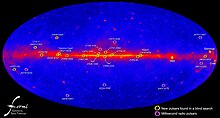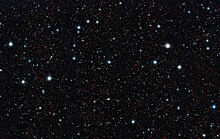Astronomical survey


An astronomical survey is a general map or image of a region of the sky that lacks a specific observational target. Alternatively, an astronomical survey may comprise a set of many images or spectra of objects that share a common type or feature. Surveys are often restricted to one band of the electromagnetic spectrum due to instrumental limitations, although multiwavelength surveys can be made by using multiple detectors, each sensitive to a different bandwidth.[1]
Surveys have generally been performed as part of the production of an astronomical catalog. They may also search for transient astronomical events. They often use wide-field astrographs.
Scientific value[]
Sky surveys, unlike targeted observation of a specific object, allow astronomers to catalog celestial objects and perform statistical analyses on them without making prohibitively lengthy observations. In some cases, an astronomer interested in a particular object will find that survey images are sufficient to make telescope time entirely unnecessary.
Surveys also help astronomers choose targets for closer study using larger, more powerful telescopes. If previous observations support a hypothesis, a telescope scheduling committee is more likely to approve new, more detailed observations to test it.
The wide scope of surveys makes them ideal for finding foreground objects that move, such as asteroids and comets. An astronomer can compare existing survey images to current observations to identify changes; this task can even be performed automatically using image analysis software. Besides science, these surveys also detect potentially hazardous objects. Similarly, images of the same object taken by different surveys can be compared to detect transient astronomical events such as variable stars.[2]
List of sky surveys[]

- Optical
- Hipparchus - created the first known star catalogue with more than 850 stars. The data was incorporated into the Almagest along with the first list of stellar magnitudes and was the primary astronomical reference until modern times, 190-120 BC.
- Astrographic Catalogue - first international astronomical survey of the entire sky. The survey was performed by 18 observatories using over 22,000 photographic plates. The results have been the basis of comparison for all subsequent surveys, 1887-1975.
- Catalina Sky Survey - an astronomical survey to discover comets and asteroids.
- Pan-Andromeda Archaeological Survey
- National Geographic Society – Palomar Observatory Sky Survey (NGS–POSS) – survey of the northern sky on photographic plates, 1948–1958
- CfA Redshift Survey – A program from Harvard-Smithonian Center for Astrophysics. It began in 1977 to 1982 then from 1985 to 1995.
- Digitized Sky Survey – optical all-sky survey created from digitized photographic plates, 1994
- 2dF Galaxy Redshift Survey (2dfGRS) – redshift survey conducted by the Anglo-Australian Observatory between 1997 and 2002
- Sloan Digital Sky Survey (SDSS) – an optical and spectroscopic survey, 2000–2006 (first pass)
- – a survey with 37,440 individual exposures, 2010–2011.[4][5]
- DEEP2 Redshift Survey (DEEP2) – Used Keck Telescopes to measure redshift of 50,000 galaxies
- VIMOS-VLT Deep Survey (VVDS) – Franco-Italian study using the Very Large Telescope at Paranal Observatory
- Palomar Distant Solar System Survey (PDSSS)
- WiggleZ Dark Energy Survey[6] (2006–2011) used the Australian Astronomical Observatory
- Dark Energy Survey (DES)[7] is a survey about one-tenth of the sky to find clues to the characteristics of dark energy.-
- Calar Alto Legacy Integral Field Area Survey (CALIFA) – a spectroscopic survey of galaxies
- SAGES Legacy Unifying Globulars and GalaxieS (SAGES Legacy Unifying Globulars and GalaxieS Survey (SLUGGS) survey[8] – a near-infrared spectro-photometric survey of 25 nearby early-type galaxies (2014)
- Large Sky Area Multi-Object Fiber Spectroscopic Telescope (LAMOST)[9] – an extra-galactic and stellar spectroscopic survey
- IPHAS and VPHAS+ – surveys of the Galactic bulge and inner disk using the Isaac Newton Telescope (north) and VLT Survey Telescope (south) in u, g, r, Hα, and i bands, 2003–present
- Pan-STARRS – a proposed 4-telescope large-field survey system to look for transient and variable sources
- Optical Gravitational Lensing Experiment (OGLE) – large-scale variability sky survey (in I and V bands), 1992–present
- DESI Legacy Imaging Surveys (Legacy Surveys) - large imaging survey of the extragalactic sky, in three bands and covering one third of the sky, 2013–present
- Infrared
 Massive galaxies discovered in the early Universe of the UltraVISTA field.[10]
Massive galaxies discovered in the early Universe of the UltraVISTA field.[10]- Infrared Astronomical Satellite did an all sky survey at 12, 25, 60, and 100 μm, 1983
- The 2-micron All-Sky Survey (2MASS), a ground-based all sky survey at J, H, and Ks bands (1.25, 1.65, and 2.17 μm) 1997–2001
- Akari (Astro-F) a Japanese mid and far infrared all-sky survey satellite, 2006–2008
- Wide-field Infrared Survey Explorer (WISE) was launched in December 2009 to begin a survey of 99% of the sky at wavelengths of 3.3, 4.7, 12, and 23 μm. The telescope is over a thousand times as sensitive as previous infrared surveys. The initial survey, consisting of each sky position imaged at least eight times, was completed by July 2010.
- UKIRT Infrared Deep Sky Survey (UKIDSS) – a collection of ground based northern hemisphere surveys (GPS, GCS, LAS, DXS, UDS) using the camera on UKIRT, some wide and some very deep, in Z, Y, J, H, & K bands 2005–
- VISTA public surveys – a collection of ground based southern hemisphere surveys (VVV, VMC, VHS, VIKING, VIDEO, UltraVISTA), of various areas and depths, in Z, Y, J, H, & Ks bands, 2009–present
- SCUBA-2 All Sky Survey
- Radio
- HIPASS – Radio survey, the first blind HI survey to cover the entire southern sky. 1997–2002
- Ohio Sky Survey – Over 19,000 radio sources at 1415 MHz. 1965–1973.
- NVSS – Survey at 1.4 GHz mapping the sky north of −40 deg
- FIRST – Survey to look for faint radio sources at twenty cms.[11]
- SUMSS - Survey at 843 MHz, mapping the sky south of -30 deg with similar sensitivity and resolution to the northern NVSS [12]
- PALFA Survey – On-going 1.4 GHz survey for radio pulsars using the Arecibo Observatory.
- GALEX Arecibo SDSS Survey GASS[13] designed to measure the neutral hydrogen content of a representative sample of ~1000 massive, galaxies
- C-BASS – On-going 5 GHz all sky survey to aid in the subtraction of galactic foregrounds from maps of the Cosmic Microwave Background
- EMU – A large radio continuum survey covering 3/4 of the sky, expected to discover about 70 million galaxies
- GMRT - The Giant Metrewave Radio Telescope's TGSS ADR mapped the sky at 150 MHz.
- – A pulsar and radio transients survey of the northern and southern sky using the Parkes Radio Telescope and the Effelsberg telescope.
- Gamma-ray
- Fermi Gamma-ray Space Telescope, formerly referred to as the "Gamma-ray Large Area Space Telescope (GLAST)." 2008–present; the goal for the telescope's lifetime is 10 years.
- Multi-wavelength surveys
- GAMA – the Galaxy And Mass Assembly survey[14] combines data from a number of ground- and space-based observatories together with a large redshift survey, performed at the Anglo-Australian Telescope. The resulting dataset aims to be a comprehensive resource for studying the physics of the galaxy population and underlying mass structures in the recent universe.[15]
- GOODS – The Great Observatories Origins Deep Survey.
- COSMOS – The Cosmic Evolution Survey
- (The latter two surveys are joining together observations obtained from space with the Hubble Space Telescope, the Spitzer Space Telescope, the Chandra X-ray Observatory and the XMM-Newton satellite, with a large set of observations obtained with ground-based telescopes).
- Atlas 3d Survey – sample of 260 galaxies for the Astrophysics project.[16]
- Planned
- Vera C. Rubin Observatory – a proposed very large telescope designed to repeatedly survey the whole sky that is visible from its location
- ASKAP HI All Sky Survey (WALLABY) – PI Bärbel Koribalski
Surveys of the Magellanic Clouds[]
- MCELS (Magellanic Cloud Emission-line Survey)
- – UBVI (optical)
- Deep Near Infrared Survey (DENIS) – near-IR
See also[]
| Wikimedia Commons has media related to Astronomical catalogues and surveys. |
- See astronomical catalogue for a more detailed description of astronomical surveys and the production of astronomical catalogues
- Redshift surveys are astronomical surveys devoted to mapping the cosmos in three dimensions
- Category:astronomical catalogues—List of astronomical catalogues on Wikipedia
- Astrograph for a type of instrument used in Astronomical surveys.
- Timeline of astronomical maps, catalogs, and surveys
References[]
- ^ See, for example, Lacy, M., Riley, J. M., Waldram, E. M., McMahon, R. G., & Warner, P. J. (1995). "A radio-optical survey of the North Ecliptic CAP". Monthly Notices of the Royal Astronomical Society. 276 (2): 614–626. Bibcode:1995MNRAS.276..614L. doi:10.1093/mnras/276.2.614.CS1 maint: uses authors parameter (link)
- ^ Gay, Dr. Pamela; Cain, Fraser (26 May 2008). "Episode #90: The Scientific Method". Astronomy Cast (Podcast). Retrieved 16 Dec 2009.
- ^ "3D Map of Distant Galaxies Completed – VLT survey shows distribution in space of 90 000 galaxies". www.eso.org. Retrieved 16 December 2016.
- ^ Risinger, Nick. "Phototopic Sky Survey". Retrieved 12 May 2011.
- ^ Associated Press (12 May 2011). "Amateur Photographer Links 37,000 Pics in Night-Sky Panorama". Fox News. Retrieved 13 May 2011.
- ^ "WiggleZ Dark Energy Survey | Home". Wigglez.swin.edu.au. Retrieved 2014-03-03.
- ^ "darkenergysurvey.org". darkenergysurvey.org. Retrieved 2014-03-03.
- ^ "SLUGGS survey webpage".
- ^ "LAMOST survey webpage".
- ^ "The Birth of Monsters". Retrieved 14 December 2015.
- ^ "The VLA FIRST Survey". Sundog.stsci.edu. 2008-07-21. Retrieved 2014-03-03.
- ^ "SUMSS: a wide-field radio imaging survey of the southern sky - II. The source catalogue". Monthly Notices of the Royal Astronomical Society. pp. 1117–1130.
- ^ "The GALEX Arecibo SDSS Survey". Mpa-garching.mpg.de. Retrieved 2014-03-03.
- ^ gama-survey.org
- ^ Driver, Simon P.; Norberg, Peder; Baldry, Ivan K.; Bamford, Steven P.; Hopkins, Andrew M.; Liske, Jochen; Loveday, Jon; Peacock, John A.; Hill, D. T.; Kelvin, L. S.; Robotham, A. S. G.; Cross, N. J. G.; Parkinson, H. R.; Prescott, M.; Conselice, C. J.; Dunne, L.; Brough, S.; Jones, H.; Sharp, R. G.; Van Kampen, E.; Oliver, S.; Roseboom, I. G.; Bland-Hawthorn, J.; Croom, S. M.; Ellis, S.; Cameron, E.; Cole, S.; Frenk, C. S.; Couch, W. J.; et al. (2009). "GAMA: towards a physical understanding of galaxy formation". Astronomy & Geophysics. 50 (5): 5.12. arXiv:0910.5123. Bibcode:2009A&G....50e..12D. doi:10.1111/j.1468-4004.2009.50512.x.
- ^ "Atlas3D Survey". Astro.physics.ox.ac.uk. Retrieved 2014-03-03.
- Astronomical surveys
- Astronomical imaging
- Observational astronomy
- Works about astronomy
